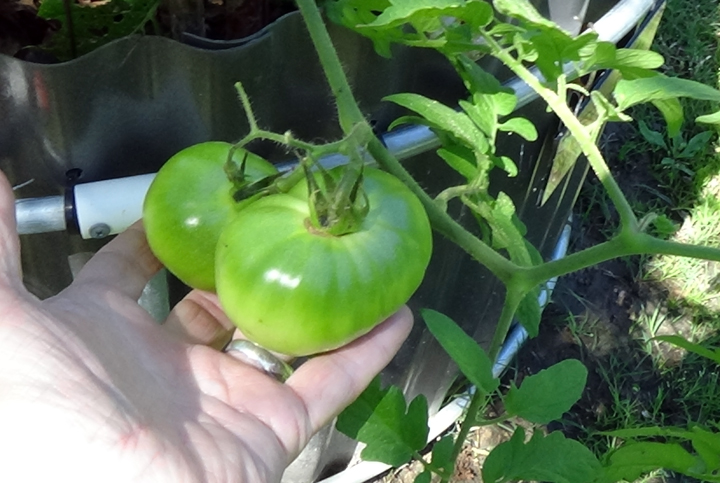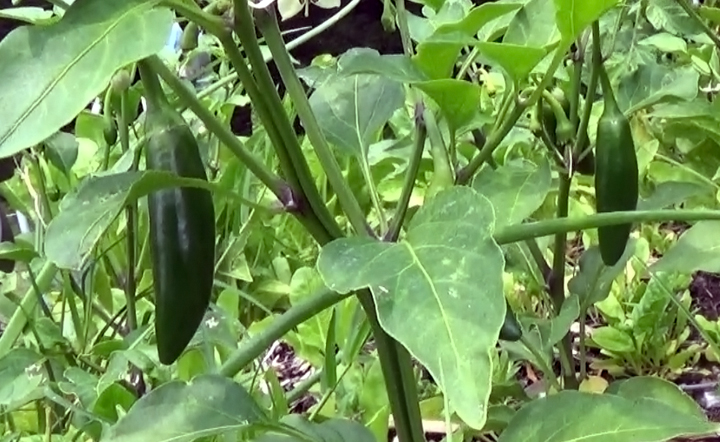 We are into early May and the keyhole gardens at the Keyhole Farm experiment station are looking quite well. We have begun harvesting spring crops and more are nearing that point.
We are into early May and the keyhole gardens at the Keyhole Farm experiment station are looking quite well. We have begun harvesting spring crops and more are nearing that point.
 Even though spring is a great time to develop a keyhole garden, it’s never too late because of various growing seasons. I am already making plans for the summer session, when some of the current crops quit making, leaving room for new plantings. Of course, two of my most productive summer crops are okra and black-eyed peas. It is also when my watermelons fully develop.
Even though spring is a great time to develop a keyhole garden, it’s never too late because of various growing seasons. I am already making plans for the summer session, when some of the current crops quit making, leaving room for new plantings. Of course, two of my most productive summer crops are okra and black-eyed peas. It is also when my watermelons fully develop.
Anyway, back to spring. On this page are a few random images of some of the crops being harvested as of today. Here, green beans are producing strongly and some black-eyed peas that I planted early and germinated prior to planting are showing signs of forming pods. There are also onions, lots of tomatoes, crook-neck squash, jalapenos, early peas, and much more. Maturity is happening pretty much as I expected.
 It appears that the leaves on the vast number of potatoes I planted are beginning to show signs of age, meaning that in the not-too-far-off future when the above-ground foliage dies, they will be ready to dig up.
It appears that the leaves on the vast number of potatoes I planted are beginning to show signs of age, meaning that in the not-too-far-off future when the above-ground foliage dies, they will be ready to dig up.
 The carrots are starting to show their leafy heads and other plants are beginning to develop, as well. Most of my keyhole gardens are loaded to the hilt, making it somewhat like a jungle to search for those magnificent green beans.
The carrots are starting to show their leafy heads and other plants are beginning to develop, as well. Most of my keyhole gardens are loaded to the hilt, making it somewhat like a jungle to search for those magnificent green beans.
I encourage everyone who has not experienced the benefits of having a keyhole garden to give it a try. There are a number of ways to build them on your own as DIY projects, or you can order a keyhole garden kit from us, which are much easier and faster to put together.
 Ours are the original kits, having been around since the opening days of keyhole gardening in the United States about eight years ago. They are quite popular based on so many return customers who want another one, or two, or three, etc.
Ours are the original kits, having been around since the opening days of keyhole gardening in the United States about eight years ago. They are quite popular based on so many return customers who want another one, or two, or three, etc.
To me, keyhole gardens are the perfect system. The process involves recycling left-overs into the internal feeding basket so that the soil and ultimately the crops receive natural nutrients. Keyholes are good for water conservation, because you only water the raised-bed garden. One of the most important benefits is not having to bend down and work on the ground, making planting, tending, and harvesting much easier.
 On top of all this, you control the soil and the material into which the crops develop, plus you choose when to harvest, allowing crops to reach their individual peaks, which increases the nutritional value and improves the taste of the crops.
On top of all this, you control the soil and the material into which the crops develop, plus you choose when to harvest, allowing crops to reach their individual peaks, which increases the nutritional value and improves the taste of the crops.
 Also, in keyhole gardens, seeds can be planted much closer together than in a traditional ground-row garden. I quite often poke holes in the soil about three inches apart in a grid format and then drop a couple of seeds in each hole and cover them up, with great results. All-in-all, it is a fairly compact, easy-to-reach method of gardening, plus they tend to do better in extreme weather condition, such as floods (which often wash away ground gardens).
Also, in keyhole gardens, seeds can be planted much closer together than in a traditional ground-row garden. I quite often poke holes in the soil about three inches apart in a grid format and then drop a couple of seeds in each hole and cover them up, with great results. All-in-all, it is a fairly compact, easy-to-reach method of gardening, plus they tend to do better in extreme weather condition, such as floods (which often wash away ground gardens).
Many youths are learning gardening via keyholes and we hope that this continues and is expanded upon. Learning to raise your own crops is an invaluable experience this day in time and it is kind of like riding a bike — it stays with you. Having your own “keyhole farm” in your backyard is an excellent way to get the whole family involved. It is a forever learning experience that is exciting, challenging, and reaps enormous rewards.
 There is a special magic in seeing the seeds you planted grow into fabulous towers of green and then harvesting the crops for the kitchen table. There is a certain pride that comes from knowing “if you can do this,” the sky is the limit.
There is a special magic in seeing the seeds you planted grow into fabulous towers of green and then harvesting the crops for the kitchen table. There is a certain pride that comes from knowing “if you can do this,” the sky is the limit.
In some ways, the world of raising crops is like a whole new galaxy that involves mathematics, science, art, meteorology, and nature in a way that becomes intuitive as just part of the process of understanding plants. You can be successful at any level, whether you dig deeply into the educational factors or simply skim the surface. It is an enjoyable learning experience whether this is a goal or not.